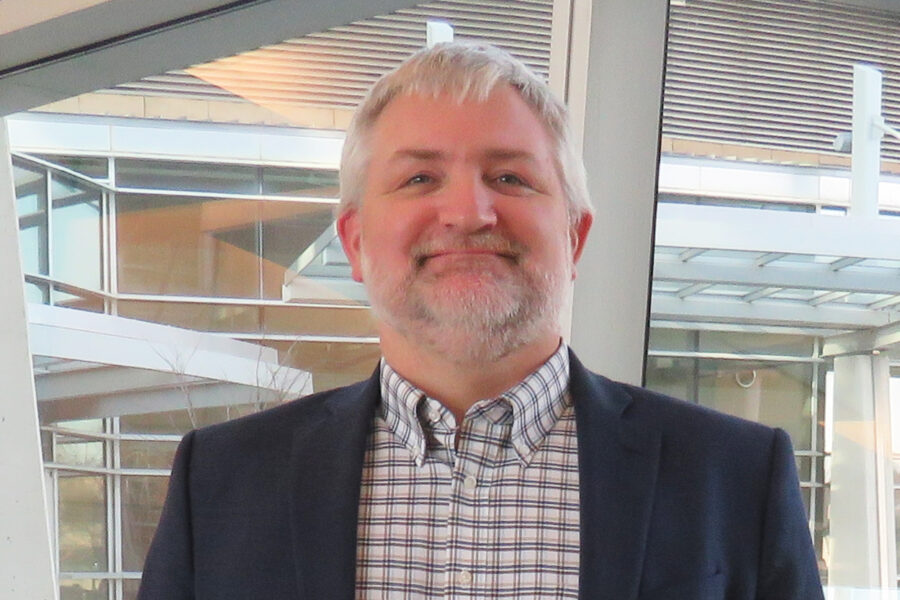Seth Winfree, PhD, assistant professor of pathology and microbiology at UNMC, is one of the lead authors on a paper recently published in the journal Nature.
The paper – “An Atlas of Healthy and Injured Cell States and Niches in the Human Kidney” – is the result of efforts by National Institutes of Health-funded consortia of researchers, including Dr. Winfree, which together will be releasing an initial collection of nine papers across the Nature publishing group this summer.
The paper’s authors call the work a “high resolution cellular atlas of 100 cell types that include rare and novel cell populations. The multi-omic approach provides detailed transcriptomic profiles, epigenomic regulatory factors, and spatial localizations for major cell types spanning the entire kidney.”
This “atlas” paper is central to developing the multi-omic and spatially defined molecular signatures of the kidney in health and disease, Dr. Winfree said.
Drawing largely from the work of two consortia – HUBMAP, the Human Biomolecular Atlas Program, and KPMP, the Kidney Precision Medicine Project – the new paper offers what Dr. Winfree calls an “unprecedented” cell and anatomical-level atlas.
“This work will provide a molecular roadmap and context for us to understand disease states as well as normal physiology of the human kidney,” Dr. Winfree said.
Producing the paper took six years of combined research from 19 institutions and two years of writing. The result, Dr. Winfree said, will provide “a roadmap to generate new hypotheses that can be tested and move us toward a better understanding of acute kidney injury and chronic kidney disease.”
The atlas, he said, will provide the molecular information that can be explored in relation to clinical information. “That’s been one of the primary objectives of the entire work.”
In the paper, the authors draw correlations with clinical outcomes based on cell types and cell states identified in the atlas.
“These are initial observations, not things that are clinically actionable,” Dr. Winfree said. “But now we can take a clinical diagnosis – for instance, acute kidney injury or chronic kidney disease – and begin to understand those diseases molecularly – to begin unpacking kidney disease and identify novel mechanisms.”
The atlas also will help kidney researchers across the globe develop new hypotheses based on this data.
“Not only will we be able to classify diseases in a new way, but we potentially can come up with new strategies to tackle the disease as well.”
Joseph Khoury, MD, chair of the UNMC Department of Pathology and Microbiology, said: “This work by Dr. Winfree and the team is a quantum leap in integrative genomics, epigenetics and transcriptomics. I say this because not only do they present a definitive body of work to understand the pathophysiology of renal diseases at a deep cellular level, but they put it elegantly within a spatial context using innovative technology. Seth’s expertise shines throughout this landmark work.”
Dr. Winfree said: “It’s an unprecedented interrogation of essentially the same tissue from donors, across multiple platforms including imaging and genomics approaches, as well as basic clinical parameters. That’s why we think of it as an atlas – a compendium of these different interrogation approaches. You can ask questions – if I see this set of clinical parameters, what does that mean in terms of the cell types that are involved in that process? – and build up all kinds of new hypotheses addressing disease mechanisms.”
The long-term goal of the disease-focused consortia KPMP is to be able to answer three questions for patients:
- What type of kidney disease do I have?
- What will happen to me?
- What can I do about it?
“To this end, researchers in the KPMP have worked to increase the molecular information that can be captured from a single kidney biopsy,” Dr. Winfree said. This has allowed the combining of clinical data with state-of-the-art imaging, genomics and transcriptomics to better identify kidney disease and underlying molecular mechanisms.
“This publication is a first monumental step in achieving these goals.”

Beautiful work, Seth! Congrats!
Congratulations!
Congratulations Seth!
Congratulations on your great work, Dr. Winfree!
We are happy to have Seth as part of our Nephrology team 🙂
Congratulations, Seth!
Congratulations Seth! Amazing work!